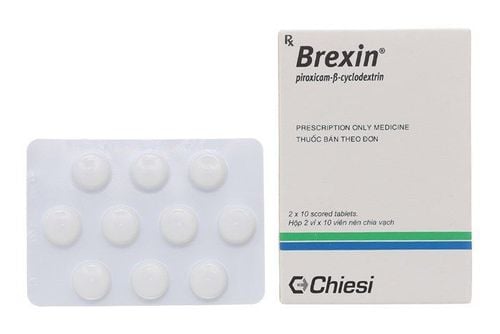This is an automatically translated article.
Speenac S is a drug commonly prescribed for pain relief and anti-inflammatory treatment for common diseases. So what is Speenac S? Let's follow the article below with the necessary information for users to ensure safety and effectiveness when taking the drug.
1. What is Speenac S?
Speenac S medicine contains the active ingredient Aceclofenac with a concentration of 100ng and other excipients such as soybean oil, palm oil, white beeswax, Lecithin, Gelatin, concentrated glycerin... The drug is prepared in the form of soft capsules. Pharmacodynamics: Aceclofenac is a non-steroidal anti-inflammatory drug. The mechanism of action of this active substance is largely based on the inhibition of prostaglandin synthesis. Aceclofenac is an effective inhibitor of the enzyme cyclo-oxygenase, which is involved in the formation of prostaglandins. Pharmacokinetics: Aceclofenac is well absorbed from the gastrointestinal tract. After oral administration, peak plasma concentrations are reached about 1-3 hours. Aceclofenac is more than 99% bound to plasma proteins. The plasma elimination half-life is approximately 4 hours. The drug is mainly excreted in the urine about 2/3 of the dose and is mainly in the form of hydroxy metabolites.
2. Indications and contraindications of the drug Speenac WILL
Drug Seenac S is indicated in the treatment of pain relief and anti-inflammatory in common diseases such as:
Toothache; Injury; Backache; Osteoarthritis; Rheumatoid arthritis ; Ankylosing spondylitis. Contraindications to the drug Speenac S:
People with hypersensitivity to any ingredient of the drug. People with Asthma: Similar to non-steroidal anti-inflammatory drugs, acetylsalicylic acid and other drugs that inhibit prostaglandin synthesis, aceclofenac carries a risk of causing symptoms such as asthma attacks, acute rhinitis or urticaria. Progressive peptic ulcer. Overdose: If an overdose occurs, the obvious manifestation is that the side effects will be worse. Depending on the symptoms appear and the extent to have treatment measures. A combination of supportive and symptomatic therapy for patients should be instituted when complications such as hypotension, respiratory distress, gastrointestinal irritation, and convulsions occur.
Missed dose: Take the missed dose of Speenac S as soon as you remember it. However, when it is almost time for your next dose, skip the missed dose and take your next dose as scheduled. Do not take a double dose on your own to make up for the missed dose. Taking the medicine at the same time each day can prevent missed doses.
3. Dosage and usage
Speenac S should be taken after meals to reduce the risk of gastrointestinal effects. Speenac S should be swallowed whole, not broken in half. Adults: The recommended dose is 200mg per day in 2 divided doses every 12 hours. However, this is only a reference dose, the treatment dose and the number of times of use may change depending on the patient's condition as well as the user's location as indicated by the doctor. Children: There are not enough research documents to determine the dose and indication for children under 6 years of age. Patients with hepatic impairment: The starting dose should be reduced to 100 mg daily. Patients with renal impairment: There is no evidence that adjustment is required in this patient, however, like other non-steroidal anti-inflammatory drugs, should be used with caution.
4. Side effects of the drug Speenac WILL
When taking Speenac S, users often experience some mild and reversible side effects such as: gastrointestinal disturbances, rash, urticaria, symptoms of bedwetting, headache, dizziness, drowsiness.
5. Drug interactions
Patients prescribed Speenac S should be monitored when combined with Lithium, Digoxin, oral antidiabetic drugs, diuretics, anticoagulants and other analgesics.
6. Be careful when taking medicine
Patients often drink alcohol, when taking this or other antipyretic and analgesic drugs because of the risk of causing stomach bleeding. Patients with symptoms of gastrointestinal disorders, who have a history of gastric ulcer. The patient is recovering from surgery, has signs of infection (fever, pain...). Patients with severe liver failure, heart failure, kidney failure. Patient is taking diuretics. Elderly patient. Pregnant/lactating women: Use should be avoided. Drivers and machine operators: Should not be used while working because the unwanted effects of the drug Speenac S affect work.
7. Preservation of the drug Speenac WILL
Keep the medicine in a cool place, away from moisture and sunlight. Medicines should be kept at a temperature not exceeding 30 degrees Celsius. Keep out of reach of small children. Do not put the medicine in the refrigerator or the bathroom. When the medicine has expired or is not required to use it, do not throw the medicine down the toilet or water pipe. You can consult a doctor or environmental company for appropriate treatment. Above is information about uses, dosage and precautions when using Speenac S. Patients need to take Speenac S exactly as directed by their doctor to ensure safety for their health and maximize the effectiveness of their treatment.
Please dial HOTLINE for more information or register for an appointment HERE. Download MyVinmec app to make appointments faster and to manage your bookings easily.













